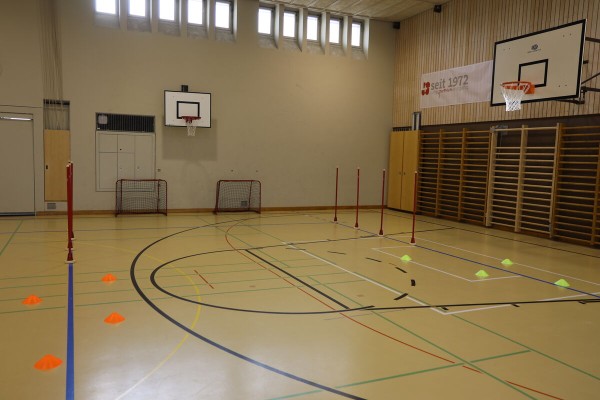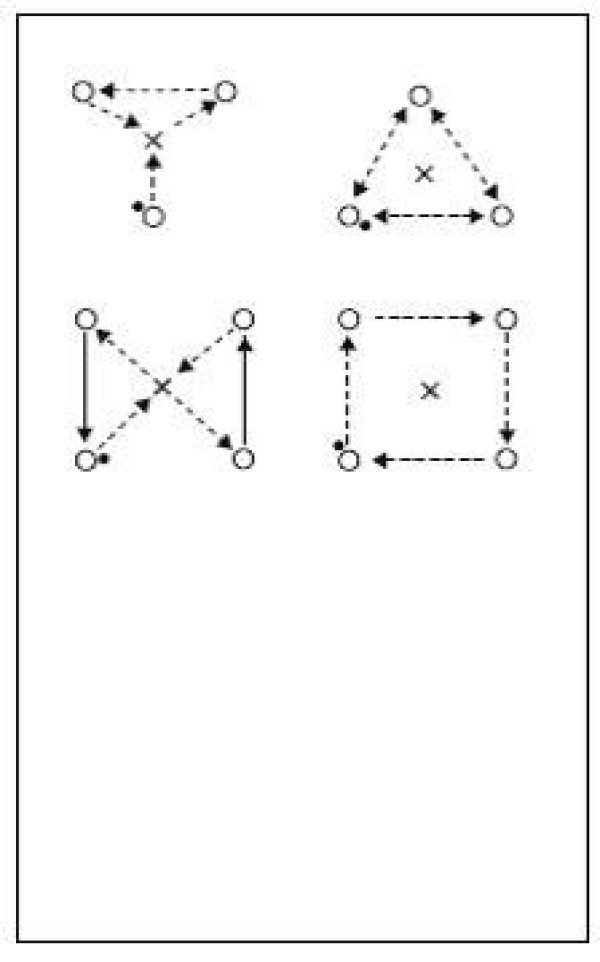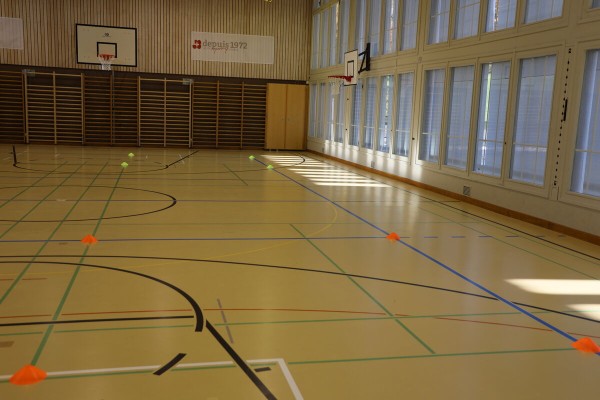Exercises (209)
Minigolf: long shot
Forms of play / exercises

Place the ball between the two box sections so that it touches the hall wall.
Caution:
If the ball is played into one of the box sections, it is moved back to the starting point. If the ball comes to a stop in front of or between the box sections, play can continue from there.
Per participant:
1 stick & ball (floorball)
2 centre sections of Swedish box
Minigolf: zigzag
Forms of play / exercises

Pass the ball between the boxes and place it in the hoop.
Caution:
If the ball comes to a stop between the boxes, play can continue from there.
Per participant:
1 stick & ball (floorball)
2 long benches
1 Swedish box (small if available)
1 hoop
Minigolf: zigzag
Forms of play / exercises

Pass the ball between the boxes and place it in the hole.
Caution:
If the ball comes to a stop between the boxes, play can continue from there.
Per participant:
1 stick & ball (floorball)
2 long benches
1 Swedish box (small if available)
1 ground socket for post
1 stake
Minigolf: zigzag
Forms of play / exercises

Pass the ball between the stakes and place it in the hole.
Per participant:
1 stick & ball (floorball)
1 ground socket for post
8-10 stakes
Passport stress
Forms of play / exercises
Partner work
The pair stand opposite each other (facing their partner). A distance of approx. 3-4 metres is maintained between the binomial. The binomial tries to string together 10 successful passes as quickly as possible. A pass is successful if the throwing disc (the frisbee), the ball (with the playing equipment) is caught or the shuttle (ball) is returned correctly. If a mistake is made (the disc or the ball/shuttle falls to the ground), the count starts again. The distance can be varied as desired after a successful attempt.
Variant I:
Multiple groups of 2 compete against each other (2 rows). The winning binomial is the one that is the first to string together 10 successful passes after the sports director's start signal. After each pass, the distance is increased (one row moves back 1-2 steps).
Variant II:
The sports leader specifies a throwing/striking/passing technique, provided that the individual techniques have already been practised.
Per participant:
1 bat/stick ► Intercrosse/Lacrosse, Smolball, Floorball, Badminton/Speedminton
Per group of 2:
1 disc (Frisbee)/ball/shuttle ► Frisbee Ultimate, Basketball, Blitzball/Rugby/Football, FooBaSKILL, Futsal/Football, Handball, Intercrosse/Lacrosse, Smolball, Floorball, Volleyball, Badminton/Speedminton
Passport stress
Forms of play / exercises
Partner work
The pair stand opposite each other (facing their partner). A distance of approx. 3-4 metres is maintained between the binomial. The binomial tries to string together 10 successful passes as quickly as possible. A pass is successful if the throwing disc (the frisbee), the ball (with the playing equipment) is caught or the shuttle (ball) is returned correctly. If a mistake is made (the disc or the ball/shuttle falls to the ground), the count starts again. The distance can be varied as desired after a successful attempt.
Variant I:
Multiple groups of 2 compete against each other (2 rows). The winning binomial is the one that is the first to string together 10 successful passes after the sports director's start signal. After each pass, the distance is increased (one row moves back 1-2 steps).
Variant II:
The sports leader specifies a throwing/striking/passing technique, provided that the individual techniques have already been practised.
Per participant:
1 racket/stick ► Intercrosse/Lacrosse, Smolball, Floorball, Badminton/Speedminton, Street Racket
Per group of 2:
1 throwing disc (Frisbee)/ball/shuttle ► Frisbee Ultimate, Basketball, Blitzball/Rugby/Football, FooBaSKILL, Futsal/Football, Handball, Intercrosse/Lacrosse, Smolball, Floorball, Volleyball, Badminton/Speedminton, Street Racket
Fits
Forms of play / exercises
Group work
4-6 participants per group
All participants move freely in the hall/area. Within the group, the participants pass a ball/throwing disc to each other. The sports leader can specify types of pass (e.g. ground pass, high pass, inside and outside instep, backhand, forehand, etc.) and throwing disc/ball receptions (e.g. one/two-handed catching, receiving with the sole of the foot, etc.). The exercise is then rearranged so that one group (e.g. blue) plays the ball/throwing disc to the other group (e.g. red) and in turn receives the ball/throwing disc from another group (e.g. green). The sports leader can integrate additional balls/throwing discs into the exercise.
Variant:
If the sports leader calls out the colour of a group with the addition "column" (e.g. "blue column"), the called group lines up in a row facing the back of the person in front (distance between the participants approx. 1-2 metres). Next, the sports leader calls a command for another group (e.g. command "red slalom"), which performs a movement task with the ball/throwing disc around the group lined up in column (e.g. bouncing the ball, guiding the ball with the feet or balancing the ball on a piece of equipment). The participant who has passed the slalom then passes the ball back to the next group member (e.g. past the lined-up group or between the spread legs). Once all group members have completed the slalom, all participants move freely around the hall/area again.
Per participant:
1 stick/stick ►intercrosse/lacrosse, smolball, floorball
1 wristband/stick ►team identification
Per group:
1 ball/throwing disc (Frisbee) ►Basketball, Frisbee Ultimate, FooBaSKILL, Futsal/Football, Handball, Intercrosse/Lacrosse, Smolball, Tchoukball, Floorball
Sports leader:
x additional balls/throwing discs (optional)
Passport collector
Forms of play / exercises
Group work
2 teams
Exercise description:
Two teams play against each other in a predetermined field. The aim is to play as many passes as possible within the team before an opponent can intercept the ball/throwing disc or the ball/throwing disc falls to the ground. If the pass attempt is intercepted or the ball/throwing disc falls to the ground, the right to pass the ball/disc changes hands and the other team now tries to collect as many successful passes as possible. Optional additional rule for more intensity: If a player in possession of the ball/disc is touched by a defender, he must immediately (within 2-3 seconds) play a pass, otherwise the right to attack also changes. Which team has achieved the most passes after a certain time?
Variant:
10 passes in a row result in one point, after which the right to the ball/disc changes.
1 ball/throwing disc ►Basketball, Blitzball/Touchrugby, Frisbee Ultimate, FooBaSKILL, Futsal/Football, Handball, Intercross/Lacrosse, Smolball, Tchoukball, Floorball
4 marking cones/caps (optional) ►Field markings
x playing ribbons/bibs ►Team identification
Pro Tn:
1 stick ►intercross/lacrosse, floorball
1 stick ►smolball
Tyre guard
Forms of play / exercises
Group work
2 teams
Two teams play against each other in a limited playing area. A point is scored if a pass is made to a teammate who has at least one leg in a hoop. The defending team can block a hoop by placing a foot in it so that no points can be scored there (more hoops than defenders are needed for this type of exercise). The right to attack changes either after a certain time or after each loss of the ball or disc. The rules of the respective game form naturally apply (e.g. Smolball, Intercrosse/Lacrosse, Floorball, Frisbee Ultimate, Howler).
Variant I:
The exercise form can be played with all balls, throwing discs or game equipment. The throwing/passing technique or passing technique can be specified.
Variant II:
Use more than one ball.
Participant:
1 stick/stick ►Intercrosse/Lacross, Smolball, Floorball
1-3 balls ►Basketball, Blitzball/Touchrugby, Frisbee Ultimate, FooBaSKILL, Futsal/Football, Handball, Intercrosse/Lacross, Smolball, Tchoukball, Floorball
4 marking cones/caps ►Field markings (optional)
x hoops
x playing ribbons/rubbers ►Team identification
Tyre relay
Forms of play / exercises
Group work
4-6 participants per group
The first participant in the group runs (alone) to the turnaround, slips through a tyre there and runs back to the group. Now the first participant runs with the second participant (holding hands) to the turning point, where they have to slip through the tyre again. The hands must not be released. This scenario is repeated until the entire group has slipped through the hoop (together with constant hand grasping). After this round, the first participant (who has travelled the longest so far) is allowed to disengage and the remaining group members continue the exercise. Finally, only the participant who was the last to join the group runs. At the end, all participants in the group have completed the same number of runs. Which group was the first to complete the task?
Per group:
2 colouring sticks
1 tyre
Risk run
Forms of play / exercises
Group work
4-5 participants per group
The front runners compete against each other (the group can determine the order of the runners accordingly) and collect points for their group. The runners choose between reversal points at different distances (e.g. colouring stick, marker cone or cones). More risk (further distance) is rewarded with more points (3 points, 2 points, 1 point), but only the first to arrive receives the points scored, the rest go home empty-handed only the first two (or more, depending on the number of groups, e.g. the first two teams) receive points. Which group has the most points after a run (each group member completes one run), or which group is the first to score a number of points? Each run only starts at the signal of the game leader.
Possible forms of locomotion:
- four-footed forwards/backwards
- in a push-up position with a partner holding the legs up
- gamstrage grip
Per group:
4 colouring sticks
Seasickness relay
Forms of play / exercises
Group work
4-5 participants per group
The runners run to the reversal point equipped with a Smolball stick, floorball/intercrosse stick or Nordic walking stick. At the turning point, the stick/stick is held vertically to the ground. Then make 15 rotations (as quickly as possible) around the stick/stick. During the rotations, both hands hold the stick/stick blade and the head is placed on the upper hand. The group counts the number of turns out loud and, after the last turn, calls the runner back, who probably tries to reach the group while staggering, in order to hand the stick/stick to the next runner and send them on their way.
Per group:
1 Nordic walking, intercrosse or floorball stick
1 Smolball stick
Smolball: Carousel
Forms of play / exercises
Group work
Simple standard pass and shot exercise: The players stand in both corners next to the goal. The foremost player runs in a high arc into the centre in front of the goal (around the marker stick). There he receives the ball from the other side and shoots (at the height of the two cones). The passer runs up next and shoots at the goal.
Variations:
- Shooting at the empty goal or whoever has shot then stands in the goal themselves.
- The sports leader can demand different types of shots (direct shots are also possible).
Per group:
1 floorball goal
x Smolballs
4 cones
1 colouring stick
Per participant:
1 Smolball stick
Smolball: slalom and goal kick
Forms of play / exercises
Group work

The participants run through a slalom course consisting of stakes juggling with the ball on the stick, before placing the ball on the ground and dribbling it with the stick through a slalom course marked with marker cones. Once the ball reaches a defined line, a shot on goal is taken from there.
Additional strengthening task:
If you don't hit the goal, complete a strength exercise: 10x trunk bend (sit up)
2 (small/medium) goals
2-4 smolball bats (depending on the number of participants)
2-4 smolball balls (depending on the number of participants)
8 stakes
8 marker cones
Smolball: Czech square
Forms of play / exercises
Group work

3 to 4 players form a triangle or a square in a confined space (markings). An additional player goes into the centre. The outside players now pass to the centre player one after the other. The centre player passes the ball directly to the next player. The centre player decides which player to pass to.
Variations:
- The outfield players immediately take the position of the player in the middle after passing the ball.
- An additional ball is brought into play.
- Outfield players can also pass to outfield players.
- Outfield players only pass to outfield players. The player in the centre must try to touch the ball. The outfield player who last touched the ball must swap positions in the centre.
Per participant:
1 smolball bat
Per group:
1 smolball ball
Smolball: Wimbledon
Forms of play / exercises
Player against player

The players face each other like in a tennis match. A line, a net or a long bench (wide side down) serves as a boundary in the centre of the court. The playing area is defined by markings or by mutual agreement (e.g. badminton markings). The game is played according to the rules of tennis, starting from the bottom behind the baseline. A game lasts 5 to 10 minutes, after which the players switch clockwise.
This game organisation enables movement-intensive lessons with a focus on promoting playing skills in heterogeneous classes.
Variants:
- The rules are determined by mutual agreement between the opponents. Each pairing can set different rules for their game.
- Different "nets" are set up (Swedish box, long bench, badminton net, rope, etc.).
- Doubles are played.
- Different balls are used (smolball, tennis ball, table tennis ball).
- After the pass, turn around your own body axis and reorient yourself.
- The game form can also be used as a form of practice for passing (forehand / backhand; long / short passes; receiving the ball, etc.)
Per team:
1 smolball racket
Pitch:
1 long bench / vaulting box / mini tennis net
1 smolball ball
Speedminton: Conscious stroke execution
Forms of play / exercises
Groups of 2

Passing game in teams of two; during the passes, the partner is asked for the type of shot, but before the speeder has crossed the centre zone (e.g. forehand, backhand, overhead, hand change or rotation on its own axis).
Per participant:
1 speedminton racket
Per group:
1 speeder
Speedminton: Accuracy
Forms of play / exercises
Groups of 2

Passing game in teams of two; both players stand so that they have little freedom of movement (e.g. on a long bench, a vaulting box or in a hoop).
Variant:
Only one player has limited freedom of movement.
Per participant:
1 speedminton racket
Per team:
1 speeder
2 length benches / vaulting box
Speedminton: Skill
Forms of play / exercises
Groups of 2
Passing game in teams of two; every third or fifth touch of the ball, the speeder should be caught and stopped by the player
.Per participant:
1 speedminton racket
Per group:
1 speeder
Speedminton: controlled hitting and stopping
Forms of play / exercises
Groups of 2

Passing game in teams of two; before hitting back, however, the speeder is played vertically upwards and only then hit back again.
Per participant:
1 speedminton racket
Per group:
1 speeder
Speedminton: Circle game
Forms of play / exercises
Group work
6-8 participants form a circle. The game is played with a speeder, which should stay in the air as long as possible.
Variant:
Multiple speeder.
Per participant:
1 speedminton racket
Per group:
1 speeder
Speedminton: Marathonspiel
Forms of play / exercises
Groups of 2
Two players pass the speeder to each other as often as possible in a given time and count the passes. All pairs have the same distance to each other. The pair with the highest number of passes wins the game.
Per participant:
1 speedminton racket
Per team:
1 speeder
Speedminton: Round robin
Forms of play / exercises
Group work
Several speedminton courts are laid out. 4-10 players play on each court, evenly distributed over both halves of the court. The foremost players on both sides are in the court and play the speeder to each other. The remaining players wait in single file behind the playing field until it is their turn. After each shot, the respective player runs to the opposite side, lines up at the back and waits for their next shot. The player at the front of the column becomes the new batter. If a player makes a mistake (hit into the outfield or speeder falls to the ground in their own court), they are eliminated from the game. The last 2 players play a final game to 3 points.
Variant:
Ejected players have the chance to return to the game by the player who threw them out (i.e. last speeder touch before the error) being eliminated in turn.
Per team:
1 speedminton racket
Pitch:
1 speeder
Speedminton: Change hands
Forms of play / exercises
Groups of 2
Passing game in teams of two; change of hands after each shot. Who makes fewer mistakes?
Per participant:
1 speedminton racket
Per group:
1 speeder
Speedminton: Game
Forms of play / exercises
Group work

Single game for a certain number of points (e.g. 10). If the group size is uneven (e.g. 3 participants), one player enjoys a break, whereby the duration of the game is reduced (e.g. 7 points) so that waiting times are shortened.
Additional task Strengthening:
After each game, the loser completes a strength exercise: 5x push-ups
2 speedminton rackets
1 speedminton shuttle
8 marker cones